Blockchain Technology: Applications and Challenges for Accountants
VerifiedAdded on 2022/08/22
|6
|1490
|21
Report
AI Summary
This report provides a comprehensive analysis of blockchain technology, defining it as a distributed and decentralized ledger for recording digital assets. The report uses the analogy of Google Docs to explain key aspects like distribution, real-time access, and transparency. It details the components of blockchain including blocks, nodes, and miners, explaining their functions. The report then explores the applications of blockchain in accounting, highlighting its potential to enhance audit accuracy and efficiency. Finally, it addresses the issues associated with blockchain technology, such as environmental impact, regulatory challenges, and security and privacy concerns. The report includes references to support the analysis.
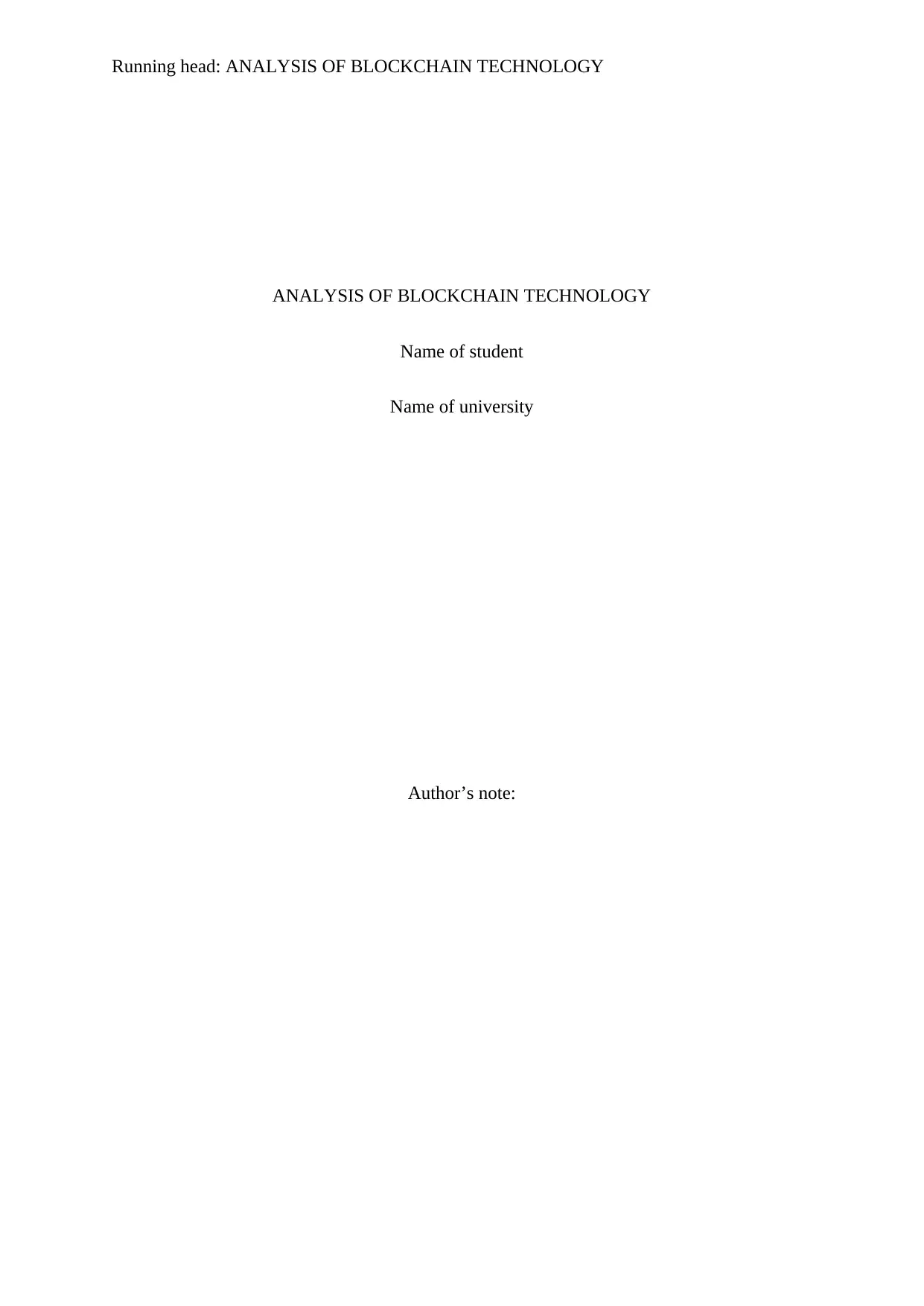
Running head: ANALYSIS OF BLOCKCHAIN TECHNOLOGY
ANALYSIS OF BLOCKCHAIN TECHNOLOGY
Name of student
Name of university
Author’s note:
ANALYSIS OF BLOCKCHAIN TECHNOLOGY
Name of student
Name of university
Author’s note:
Paraphrase This Document
Need a fresh take? Get an instant paraphrase of this document with our AI Paraphraser
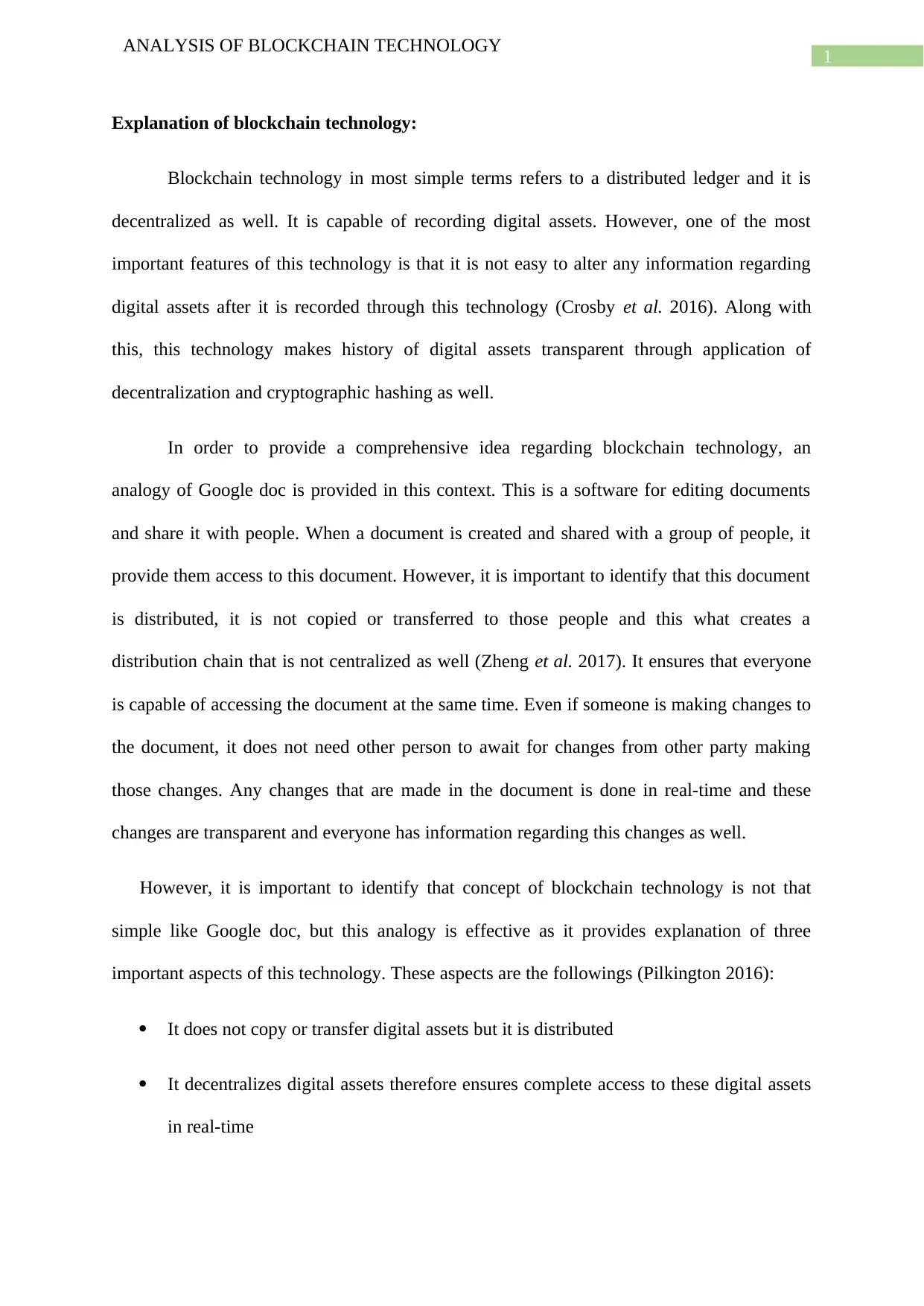
1
ANALYSIS OF BLOCKCHAIN TECHNOLOGY
Explanation of blockchain technology:
Blockchain technology in most simple terms refers to a distributed ledger and it is
decentralized as well. It is capable of recording digital assets. However, one of the most
important features of this technology is that it is not easy to alter any information regarding
digital assets after it is recorded through this technology (Crosby et al. 2016). Along with
this, this technology makes history of digital assets transparent through application of
decentralization and cryptographic hashing as well.
In order to provide a comprehensive idea regarding blockchain technology, an
analogy of Google doc is provided in this context. This is a software for editing documents
and share it with people. When a document is created and shared with a group of people, it
provide them access to this document. However, it is important to identify that this document
is distributed, it is not copied or transferred to those people and this what creates a
distribution chain that is not centralized as well (Zheng et al. 2017). It ensures that everyone
is capable of accessing the document at the same time. Even if someone is making changes to
the document, it does not need other person to await for changes from other party making
those changes. Any changes that are made in the document is done in real-time and these
changes are transparent and everyone has information regarding this changes as well.
However, it is important to identify that concept of blockchain technology is not that
simple like Google doc, but this analogy is effective as it provides explanation of three
important aspects of this technology. These aspects are the followings (Pilkington 2016):
It does not copy or transfer digital assets but it is distributed
It decentralizes digital assets therefore ensures complete access to these digital assets
in real-time
ANALYSIS OF BLOCKCHAIN TECHNOLOGY
Explanation of blockchain technology:
Blockchain technology in most simple terms refers to a distributed ledger and it is
decentralized as well. It is capable of recording digital assets. However, one of the most
important features of this technology is that it is not easy to alter any information regarding
digital assets after it is recorded through this technology (Crosby et al. 2016). Along with
this, this technology makes history of digital assets transparent through application of
decentralization and cryptographic hashing as well.
In order to provide a comprehensive idea regarding blockchain technology, an
analogy of Google doc is provided in this context. This is a software for editing documents
and share it with people. When a document is created and shared with a group of people, it
provide them access to this document. However, it is important to identify that this document
is distributed, it is not copied or transferred to those people and this what creates a
distribution chain that is not centralized as well (Zheng et al. 2017). It ensures that everyone
is capable of accessing the document at the same time. Even if someone is making changes to
the document, it does not need other person to await for changes from other party making
those changes. Any changes that are made in the document is done in real-time and these
changes are transparent and everyone has information regarding this changes as well.
However, it is important to identify that concept of blockchain technology is not that
simple like Google doc, but this analogy is effective as it provides explanation of three
important aspects of this technology. These aspects are the followings (Pilkington 2016):
It does not copy or transfer digital assets but it is distributed
It decentralizes digital assets therefore ensures complete access to these digital assets
in real-time

2
ANALYSIS OF BLOCKCHAIN TECHNOLOGY
Changes recorded in ledger are transparent and it ensures integrity of document and
therefore enhances trust in assets
In order to identify how blockchain works, it is important to analyse three main concepts
regarding this technology. These are the followings:
Blocks:
Each of the blockchains is consisted of various blocks and each of the blocks consists of three
main elements (Beck et al. 2017):
The data that is stored in the block
A nonce which is a 32-bit whole number and this number is generated randomly while
creating a block. After this nonce is generated, it then creates a block header hash as
well
A hash refers to a number which is 256-bit and this is associated with the nonce.
However, it is important to identify that this number needs to be started with large
number of zeros as well. When first block of chain is created, a cryptographic hash is
generated by the nonce. The data included in the block is then considered signed. It is then
integrated with the nonce and hash if no mining is considered as well.
Nodes:
One of the most important aspects of blockchain technology is decentralization. There
is no ownership provided to any person or organization. This is a distributed ledger that is
associated with the chain and this is done through nodes. Nodes refers to any electronic
device that is capable of storing copies of the blockchain and ensure that the network is
functioning effectively and efficiently as well (Ahram et al. 2017). Each node has its
respective copies of blockchain and if any new block is included in the chain, then the
ANALYSIS OF BLOCKCHAIN TECHNOLOGY
Changes recorded in ledger are transparent and it ensures integrity of document and
therefore enhances trust in assets
In order to identify how blockchain works, it is important to analyse three main concepts
regarding this technology. These are the followings:
Blocks:
Each of the blockchains is consisted of various blocks and each of the blocks consists of three
main elements (Beck et al. 2017):
The data that is stored in the block
A nonce which is a 32-bit whole number and this number is generated randomly while
creating a block. After this nonce is generated, it then creates a block header hash as
well
A hash refers to a number which is 256-bit and this is associated with the nonce.
However, it is important to identify that this number needs to be started with large
number of zeros as well. When first block of chain is created, a cryptographic hash is
generated by the nonce. The data included in the block is then considered signed. It is then
integrated with the nonce and hash if no mining is considered as well.
Nodes:
One of the most important aspects of blockchain technology is decentralization. There
is no ownership provided to any person or organization. This is a distributed ledger that is
associated with the chain and this is done through nodes. Nodes refers to any electronic
device that is capable of storing copies of the blockchain and ensure that the network is
functioning effectively and efficiently as well (Ahram et al. 2017). Each node has its
respective copies of blockchain and if any new block is included in the chain, then the
⊘ This is a preview!⊘
Do you want full access?
Subscribe today to unlock all pages.

Trusted by 1+ million students worldwide
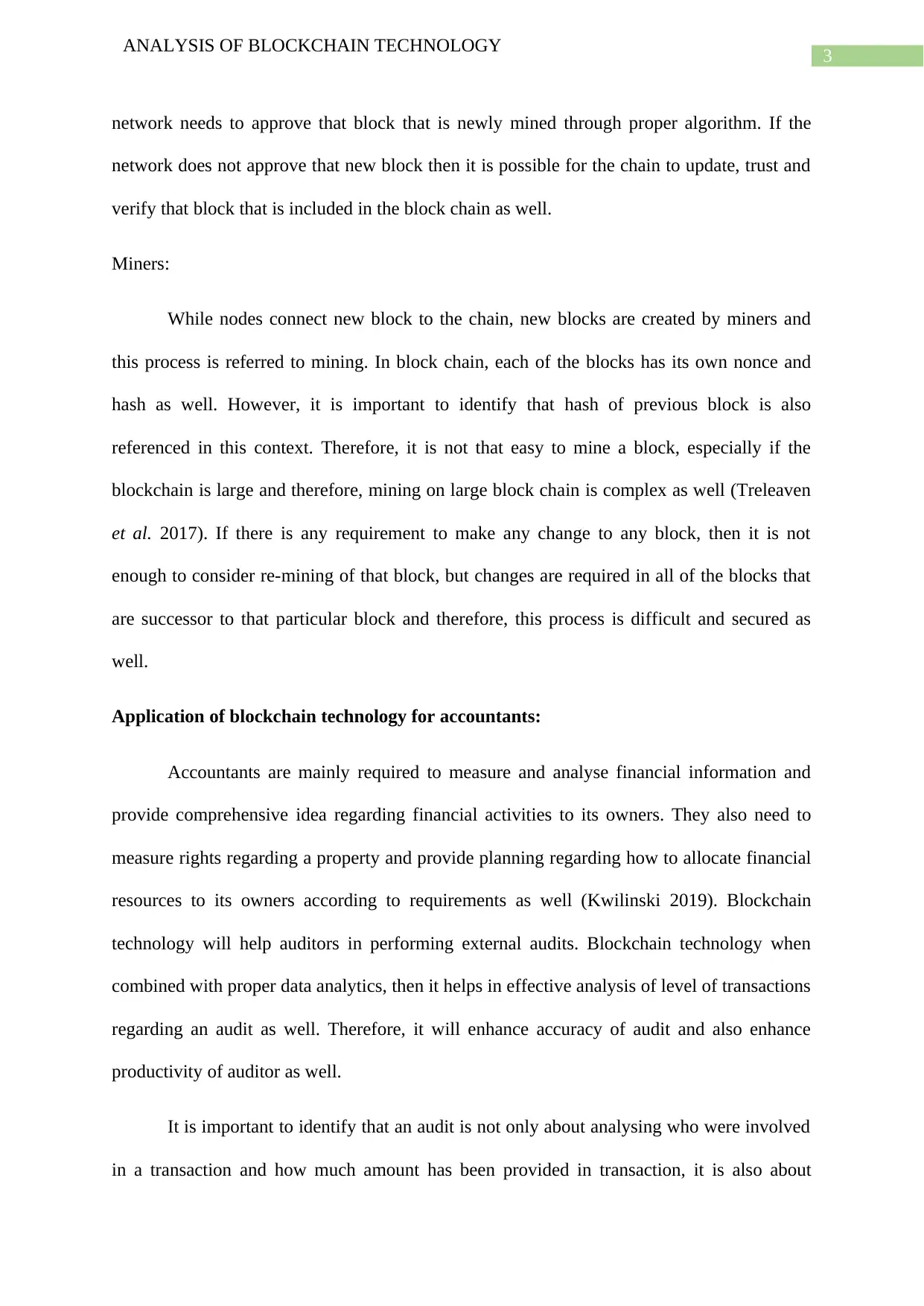
3
ANALYSIS OF BLOCKCHAIN TECHNOLOGY
network needs to approve that block that is newly mined through proper algorithm. If the
network does not approve that new block then it is possible for the chain to update, trust and
verify that block that is included in the block chain as well.
Miners:
While nodes connect new block to the chain, new blocks are created by miners and
this process is referred to mining. In block chain, each of the blocks has its own nonce and
hash as well. However, it is important to identify that hash of previous block is also
referenced in this context. Therefore, it is not that easy to mine a block, especially if the
blockchain is large and therefore, mining on large block chain is complex as well (Treleaven
et al. 2017). If there is any requirement to make any change to any block, then it is not
enough to consider re-mining of that block, but changes are required in all of the blocks that
are successor to that particular block and therefore, this process is difficult and secured as
well.
Application of blockchain technology for accountants:
Accountants are mainly required to measure and analyse financial information and
provide comprehensive idea regarding financial activities to its owners. They also need to
measure rights regarding a property and provide planning regarding how to allocate financial
resources to its owners according to requirements as well (Kwilinski 2019). Blockchain
technology will help auditors in performing external audits. Blockchain technology when
combined with proper data analytics, then it helps in effective analysis of level of transactions
regarding an audit as well. Therefore, it will enhance accuracy of audit and also enhance
productivity of auditor as well.
It is important to identify that an audit is not only about analysing who were involved
in a transaction and how much amount has been provided in transaction, it is also about
ANALYSIS OF BLOCKCHAIN TECHNOLOGY
network needs to approve that block that is newly mined through proper algorithm. If the
network does not approve that new block then it is possible for the chain to update, trust and
verify that block that is included in the block chain as well.
Miners:
While nodes connect new block to the chain, new blocks are created by miners and
this process is referred to mining. In block chain, each of the blocks has its own nonce and
hash as well. However, it is important to identify that hash of previous block is also
referenced in this context. Therefore, it is not that easy to mine a block, especially if the
blockchain is large and therefore, mining on large block chain is complex as well (Treleaven
et al. 2017). If there is any requirement to make any change to any block, then it is not
enough to consider re-mining of that block, but changes are required in all of the blocks that
are successor to that particular block and therefore, this process is difficult and secured as
well.
Application of blockchain technology for accountants:
Accountants are mainly required to measure and analyse financial information and
provide comprehensive idea regarding financial activities to its owners. They also need to
measure rights regarding a property and provide planning regarding how to allocate financial
resources to its owners according to requirements as well (Kwilinski 2019). Blockchain
technology will help auditors in performing external audits. Blockchain technology when
combined with proper data analytics, then it helps in effective analysis of level of transactions
regarding an audit as well. Therefore, it will enhance accuracy of audit and also enhance
productivity of auditor as well.
It is important to identify that an audit is not only about analysing who were involved
in a transaction and how much amount has been provided in transaction, it is also about
Paraphrase This Document
Need a fresh take? Get an instant paraphrase of this document with our AI Paraphraser
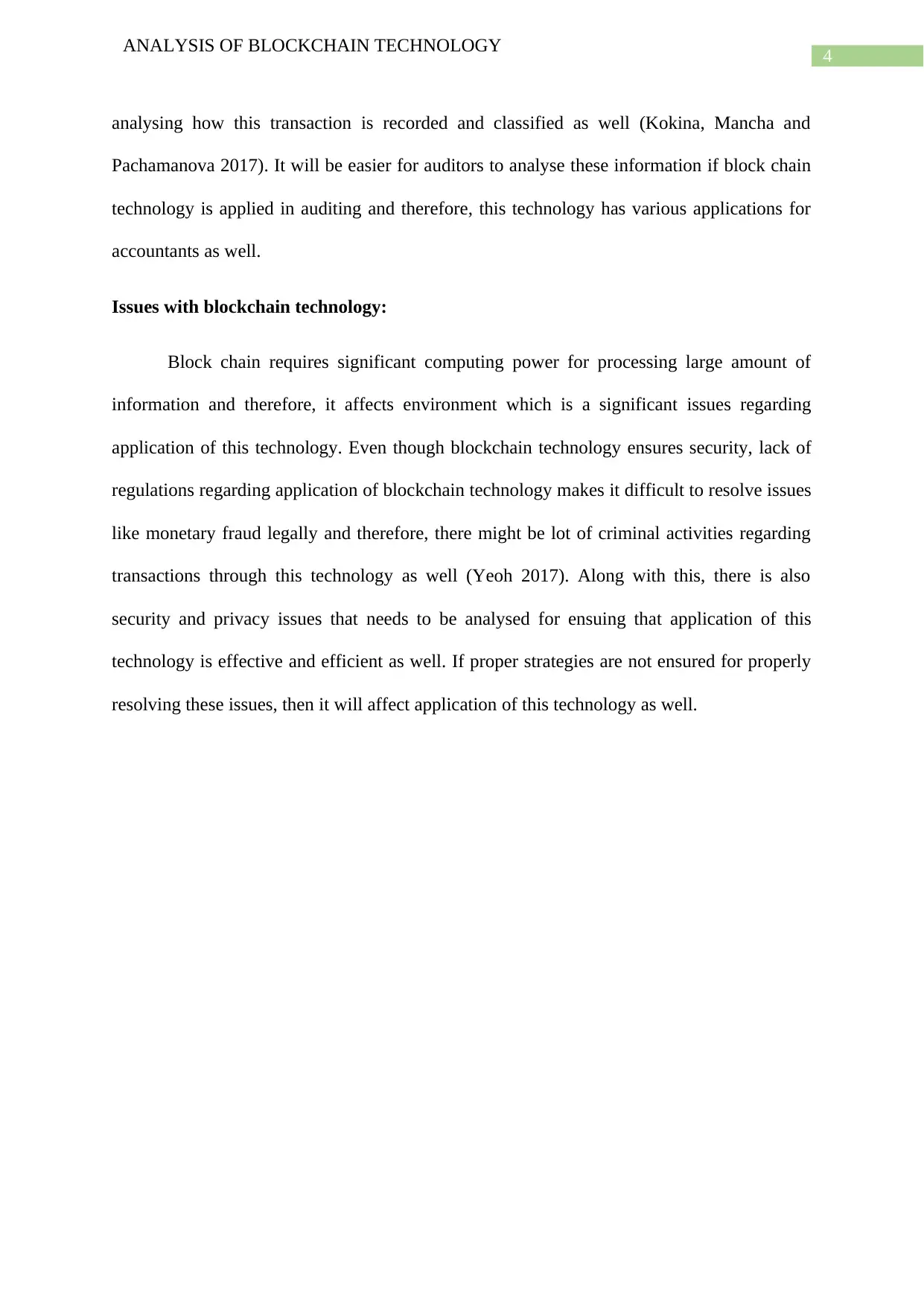
4
ANALYSIS OF BLOCKCHAIN TECHNOLOGY
analysing how this transaction is recorded and classified as well (Kokina, Mancha and
Pachamanova 2017). It will be easier for auditors to analyse these information if block chain
technology is applied in auditing and therefore, this technology has various applications for
accountants as well.
Issues with blockchain technology:
Block chain requires significant computing power for processing large amount of
information and therefore, it affects environment which is a significant issues regarding
application of this technology. Even though blockchain technology ensures security, lack of
regulations regarding application of blockchain technology makes it difficult to resolve issues
like monetary fraud legally and therefore, there might be lot of criminal activities regarding
transactions through this technology as well (Yeoh 2017). Along with this, there is also
security and privacy issues that needs to be analysed for ensuing that application of this
technology is effective and efficient as well. If proper strategies are not ensured for properly
resolving these issues, then it will affect application of this technology as well.
ANALYSIS OF BLOCKCHAIN TECHNOLOGY
analysing how this transaction is recorded and classified as well (Kokina, Mancha and
Pachamanova 2017). It will be easier for auditors to analyse these information if block chain
technology is applied in auditing and therefore, this technology has various applications for
accountants as well.
Issues with blockchain technology:
Block chain requires significant computing power for processing large amount of
information and therefore, it affects environment which is a significant issues regarding
application of this technology. Even though blockchain technology ensures security, lack of
regulations regarding application of blockchain technology makes it difficult to resolve issues
like monetary fraud legally and therefore, there might be lot of criminal activities regarding
transactions through this technology as well (Yeoh 2017). Along with this, there is also
security and privacy issues that needs to be analysed for ensuing that application of this
technology is effective and efficient as well. If proper strategies are not ensured for properly
resolving these issues, then it will affect application of this technology as well.
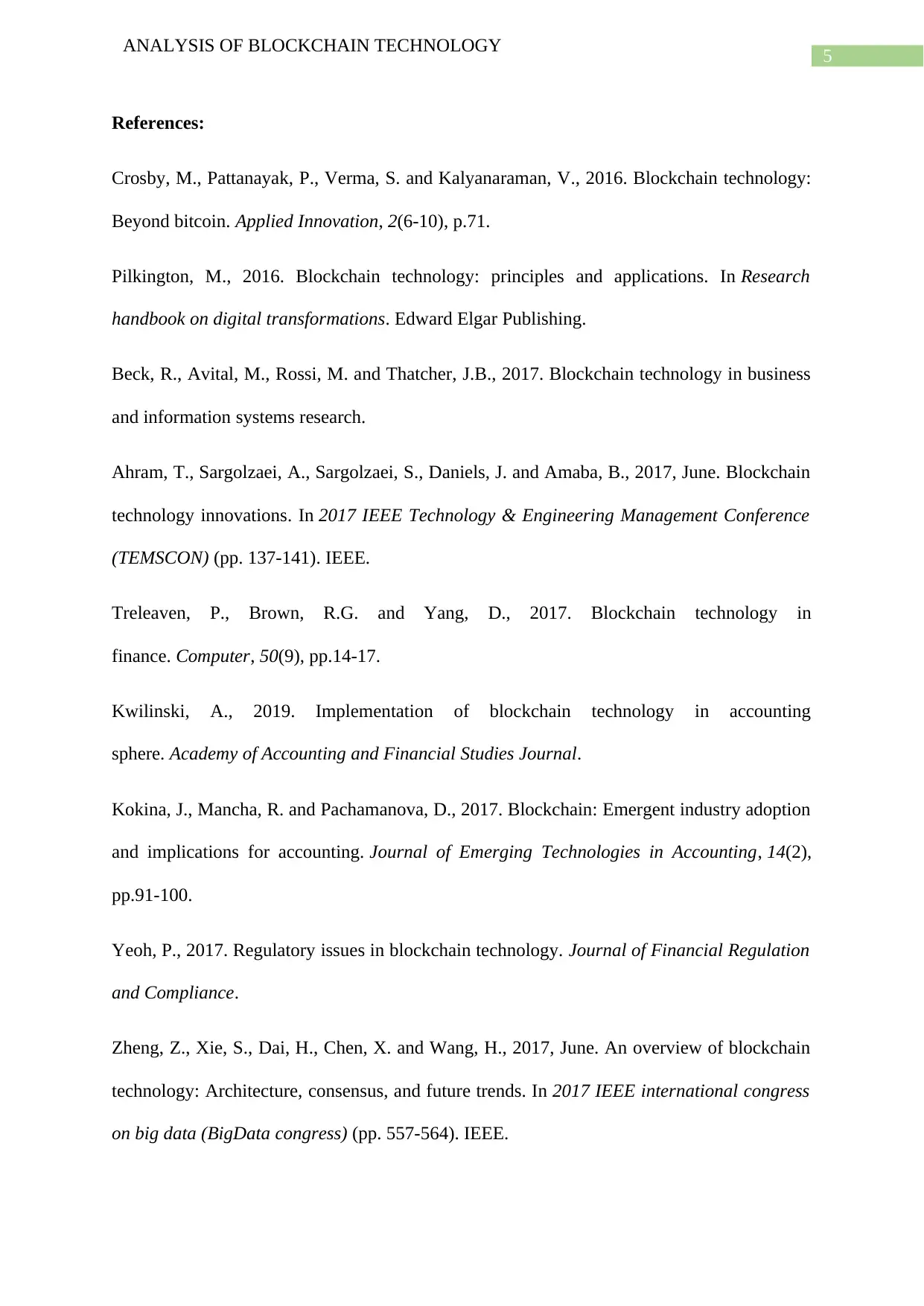
5
ANALYSIS OF BLOCKCHAIN TECHNOLOGY
References:
Crosby, M., Pattanayak, P., Verma, S. and Kalyanaraman, V., 2016. Blockchain technology:
Beyond bitcoin. Applied Innovation, 2(6-10), p.71.
Pilkington, M., 2016. Blockchain technology: principles and applications. In Research
handbook on digital transformations. Edward Elgar Publishing.
Beck, R., Avital, M., Rossi, M. and Thatcher, J.B., 2017. Blockchain technology in business
and information systems research.
Ahram, T., Sargolzaei, A., Sargolzaei, S., Daniels, J. and Amaba, B., 2017, June. Blockchain
technology innovations. In 2017 IEEE Technology & Engineering Management Conference
(TEMSCON) (pp. 137-141). IEEE.
Treleaven, P., Brown, R.G. and Yang, D., 2017. Blockchain technology in
finance. Computer, 50(9), pp.14-17.
Kwilinski, A., 2019. Implementation of blockchain technology in accounting
sphere. Academy of Accounting and Financial Studies Journal.
Kokina, J., Mancha, R. and Pachamanova, D., 2017. Blockchain: Emergent industry adoption
and implications for accounting. Journal of Emerging Technologies in Accounting, 14(2),
pp.91-100.
Yeoh, P., 2017. Regulatory issues in blockchain technology. Journal of Financial Regulation
and Compliance.
Zheng, Z., Xie, S., Dai, H., Chen, X. and Wang, H., 2017, June. An overview of blockchain
technology: Architecture, consensus, and future trends. In 2017 IEEE international congress
on big data (BigData congress) (pp. 557-564). IEEE.
ANALYSIS OF BLOCKCHAIN TECHNOLOGY
References:
Crosby, M., Pattanayak, P., Verma, S. and Kalyanaraman, V., 2016. Blockchain technology:
Beyond bitcoin. Applied Innovation, 2(6-10), p.71.
Pilkington, M., 2016. Blockchain technology: principles and applications. In Research
handbook on digital transformations. Edward Elgar Publishing.
Beck, R., Avital, M., Rossi, M. and Thatcher, J.B., 2017. Blockchain technology in business
and information systems research.
Ahram, T., Sargolzaei, A., Sargolzaei, S., Daniels, J. and Amaba, B., 2017, June. Blockchain
technology innovations. In 2017 IEEE Technology & Engineering Management Conference
(TEMSCON) (pp. 137-141). IEEE.
Treleaven, P., Brown, R.G. and Yang, D., 2017. Blockchain technology in
finance. Computer, 50(9), pp.14-17.
Kwilinski, A., 2019. Implementation of blockchain technology in accounting
sphere. Academy of Accounting and Financial Studies Journal.
Kokina, J., Mancha, R. and Pachamanova, D., 2017. Blockchain: Emergent industry adoption
and implications for accounting. Journal of Emerging Technologies in Accounting, 14(2),
pp.91-100.
Yeoh, P., 2017. Regulatory issues in blockchain technology. Journal of Financial Regulation
and Compliance.
Zheng, Z., Xie, S., Dai, H., Chen, X. and Wang, H., 2017, June. An overview of blockchain
technology: Architecture, consensus, and future trends. In 2017 IEEE international congress
on big data (BigData congress) (pp. 557-564). IEEE.
⊘ This is a preview!⊘
Do you want full access?
Subscribe today to unlock all pages.

Trusted by 1+ million students worldwide
1 out of 6
Related Documents
Your All-in-One AI-Powered Toolkit for Academic Success.
+13062052269
info@desklib.com
Available 24*7 on WhatsApp / Email
![[object Object]](/_next/static/media/star-bottom.7253800d.svg)
Unlock your academic potential
Copyright © 2020–2025 A2Z Services. All Rights Reserved. Developed and managed by ZUCOL.





